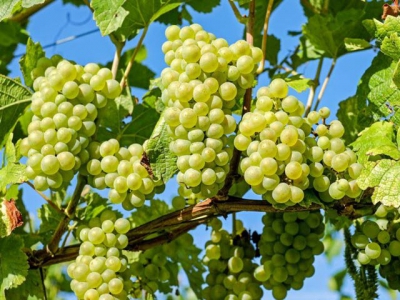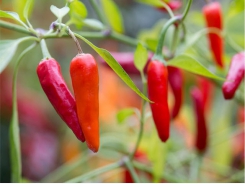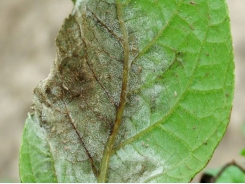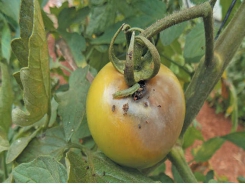The value of nets in citrus and table grape production

The farm Matroozefontein has the most westerly citrus orchards and table grape vineyards in Southern Africa. In this arid area, farming under nets has proved a success.
Italian consortium Unifrutti has been farming in Mpumalanga and the Eastern Cape since 1998. In 2004, after considering whether to produce citrus for export to the US, it bought the 2 200ha farm a short distance inland from Elands Bay. Here, the company grows citrus and table grapes on 151ha. The area under cultivation is limited by the availability of irrigation water.
Sandveld citrus production cycle
Simon Baty, farm manager and in charge of the citrus operation, recalls that the navels which were planted initially were unsuccessful in the arid Sandveld.
“But we found that lemons, Clementines, mandarins, Midnight Valencias and Late Valencias did well. So we are in the process of topping many of the citrus orchards to some of these varieties. Ultimately, we plan to have 170ha of citrus – we’re now at 104ha.”
Citrus blooms later on the West Coast – in four to six weeks in September and October – than further north. The first fruit set is in mid-October, depending on the cultivar and its age. The second drop is in late November, continuing into early December. Fruit picking starts at the end of April, depending on the cultivar.
“We start picking Clementines from the end of April until mid-June,” explains Simon. “Then we pick our early navels and move across to lemons from the last week of June until mid-July. After this we start picking late navels until mid-August. We also pick mandarins from the end of July until late August. As soon as we finish picking mandarins we start on our Midnight Valencias followed by the Late Valencia varieties. By mid-September, picking has been completed.”
Soil quality and fertilisation
The Sandveld has poor sandy soil that is low in nutrients and almost no carbon or humus. On Matroozefontein, they grow citrus mainly on the poorer and grapes on the better soil. “Oak leaf is one of our better soils, but the citrus is on the poorer-quality sand,” says Simon. “We feed these crops hydroponically and provide liquid fertiliser through the drip daily from August to the end of January.”
All micro-sprinkler and drip-irrigated blocks receive a carbon-based product, Carbotech from Patensie, through the irrigation system. Composed of humic acid, fulvic acid and amino acids, it stimulates root growth and enhances bacterial and fungal soil micro-organisms in the soil. In addition, chemical fertiliser such as 2:3:4, LAN and potassium sulphate are applied monthly from August to January in the micro-irrigated blocks.
“Because nothing in the soil holds the fertiliser, we’re careful not to over-irrigate and leach it from the soil,” explains Simon.
He stopped applying compost and pre-enriched chicken litter fertiliser to the older micro-irrigated citrus orchards a few years ago as this enhanced boron toxicity. He corrected the problem by changing the fertiliser programme.
“Farming in sand is tricky. We can quickly correct a mistake, but sand has very low buffering capacity. So, if we make a mistake, the results are immediately evident, enabling us to manage fertiliser and irrigation precisely.
“The climate here is good for citrus but table grapes do even better. For this reason, we’re phasing out unproductive navel citrus varieties and expanding table grape production,” he explains.
During picking season, approximately 120 workers are active in the citrus orchards. The yield depends on variables including the cultivar, age of the block and whether or not it is under netting.
Table grapes production cycle
Hein Koegelenberg, in charge of the table grape production, says that the vineyards cover 47ha, all under shade netting. This will eventually be expanded to 80ha. Currently, Red Globe covers 17ha, Sugra One (white seedless) 8ha, Crimson Seedless 5,2ha, Autumn Royal 2,6ha and Dan Ben Hannah (black-seeded) 2,6ha. Young vines – Tawny Seedless, Sweet Celebration and Arra 15 – together contribute another 11ha.
Pruning starts early in July and is completed by mid-August. The grapes then grow until unwanted shoots are removed from the first week of September. Later in September and into October, surplus bunches are removed to leave 28 bunches per vine. Bunch preparation starts in early November and the grapes are picked from a week before Christmas until mid-February.
Favourable conditions under shade netting enable a short growing season. About 120 workers are employed for bunch preparation and 165 for packing.
Climate for colour
This area of the semi-desert Sandveld is ideal for grapes due to its Mediterranean climate. It has a temperature range of 45°C during the day and 13°C at night in summer. In the evenings, the cooler air moves in from the sea, giving the grapes a good and uniform colour without enhancement.
“In fact, our red varieties are sometimes almost too dark. Red Globe is ready for harvest for market from week one in January,” he explains.
Soil and fertilisation
In the Sandveld, areas with better soil ironically have poorer-quality water. On Matroozefontein, the poor-quality white sand has good-quality irrigation water, which is used to irrigate the vineyards. During hot spells, they are irrigated daily, while fertiliser is applied monthly from August to February.
Shade net success
In 2002, Simon attended a conference in Spain where he was inspired by a Moroccan delegate who successfully grew citrus under shade net and obtaining a higher yield while using 40% less water.
“Our conditions here are similar: very dry and arid semi-desert, with an average annual rainfall of 200mm to 250mm, and this year just 130mm,” he says.
“When I arrived here in 2005, the first table grape crop was a disaster. We’re situated in a bird conservancy and the only large table grape grower within a 40km radius of the farm, so it was a shock to see half of our grapes destroyed by birds.
“One of our former directors, Francesco de Nadia, has experience in using nets in Chile, so he suggested that we experimentally enclose a few blocks under shade netting. We netted a block of table grapes next to an unnetted control block of the same age, rootstock and growing conditions. Our production under the net was double that of the control block. The payback period on the netting was just over a year at the time. We immediately started expanding the area of table grapes under netting,” Simon explains.
Net advantages – grapes
Vines grow vigorously under the nets, while using less fertiliser and water.
“Nets reduce the pest problem and wastage as the vines suffer little or no damage from sun, birds or wind. We get larger and more uniformly coloured berries. We need far less labour because the bunches need less preparation. When grapes get to the packhouse, they can be packed more quickly. As we produce more cartons with the same number of people, productivity is 20% to 50% higher than that of other growers in the area,” he explains.
Nets change the micro-climate beneath them.
“The higher humidity leads to better shoot elongation, reducing the fertiliser need by 10% to 15%. Annual water use is reduced to about 5 000m³/ ha on a mature block. The norm in the Berg River area is 6 000m³/ ha to 6 500m³/ha, so a 20% to 30% saving on water is realistic under nets.”
Grapes under nets also suffer fewer pest problems, he says. Snails, however, can become a factor, as birds cannot get in to eat them. Celebrex and monoxide are used as bait to kill them.
“The main advantages are the saving on labour, growth beyond expectation due to reduced climatic stress, and reduced damage to the bunches. Within 18 months of planting grapes, depending on the variety, we pick and pack 1 000 to 2 000 export cartons per hectare (4,5kg/ carton) and the following year, 3 000 to 4 000 cartons. Under nets, we achieve at 30 months, the production that normally takes four years.”
Simon says that netting table grapes is profitable, whatever the cultivar.
“We couldn’t produce table grapes here without nets. It took us three or four years to cover all the vineyards and we’ll recover our costs within four to five years.”
Grapes do best under Crystal 20% net, which provides 8% shade. Netting also extends the productive life of a block of grapes.
They come with an eight-year guarantee but, if well-maintained and properly tensioned for wind, will last for 15 years. Wind causes rubbing against the poles and wires, leading to premature wear.
Matroozefontein’s annual yield of grapes under netting (export cartons at 4,5kg and bunches 600g to 800g as packed) is 6 000 cartons/ ha for Red Globe, 6 500 cartons/ ha for Dan Ben Hannah, 5 000 cartons/ha for Crimson Seedless, 4 200 cartons/ha for Sugra One and 4 500 cartons/ ha for Autumn Royal. The rest of the vineyards are under still young vines. The farm exports grapes to the Middle East, UK, Europe and Russia.
Net advantages – citrus
In citrus, nets also reduce the leaf and fruit temperatures.
“Because of our success with grapes, we cover a 2ha block of Lane Late navels on Carrizo rootstock with different colours of net,” Simon says. “Each colour transmits a unique wavelength of light which affects plant growth differently. After four to five months, the trees under netting were already larger and more luxuriant than those under the control block outside. When we analysed leaf samples after seven months, all the elements were in balance whereas the trees outside were low in nitrogen, calcium and some trace elements,” he explains.
Measuring the leaf and fruit temperatures with an infrared thermometer showed an 8°C lower temperature under the nets on hot days (over 35°C).
“This lower temperature enables leaves to transpire naturally and the tree to take up the necessary nutrients over a longer period during the day. The nets significantly reduced climatic stress.”
The ambient air temperature may be 35°C but the sand temperature can be 55°C or higher in summer, with heat also being radiated up from the sand. Under nets, sunburn on fruit was reduced from 10% to less than 1%.
Additionally, fruit size is larger under nets, and yield up to 50% higher. The fruit count – number in a carton – peaked at 72 outside and 64 under the nets. Wind damage was also lower under the nets.
The pest pressure under the net is higher as it excludes natural parasitoids. Some pests are more prolific than others – mealybug and thrips are more of a problem but bollworm and false codling moth are not a problem. Citrus in the Sandveld does best under 18% to 20% shade netting. Citrus is exported to the Middle East, Europe, US, Canada and Russia.
Costs
Simon admits that the cost of netting is significant. “When we started, it was R120 000/ ha for table grapes. Now it’s R150 000/ ha to R170 000/ ha for grapes and about R200 000/ ha for citrus. As for citrus in the Sandveld, the latter is only economically justifiable in the case of high-paying cultivars.”
Citrus costs about R150 000/ ha to establish and netting costs a further R200 000/ ha. Simon adds that nets seem to work better in a Mediterranean climate of hot dry summers and mild wet winters. So, while they work well in the Sandveld, he advises citrus growers in other areas to conduct their own trials first.
Related news
Tools

Phối trộn thức ăn chăn nuôi

Pha dung dịch thủy canh

Định mức cho tôm ăn

Phối trộn phân bón NPK

Xác định tỷ lệ tôm sống

Chuyển đổi đơn vị phân bón

Xác định công suất sục khí

Chuyển đổi đơn vị tôm

Tính diện tích nhà kính

Tính thể tích ao




 Don’t let late blight catch you napping
Don’t let late blight catch you napping  Dealing with the African bollworm
Dealing with the African bollworm